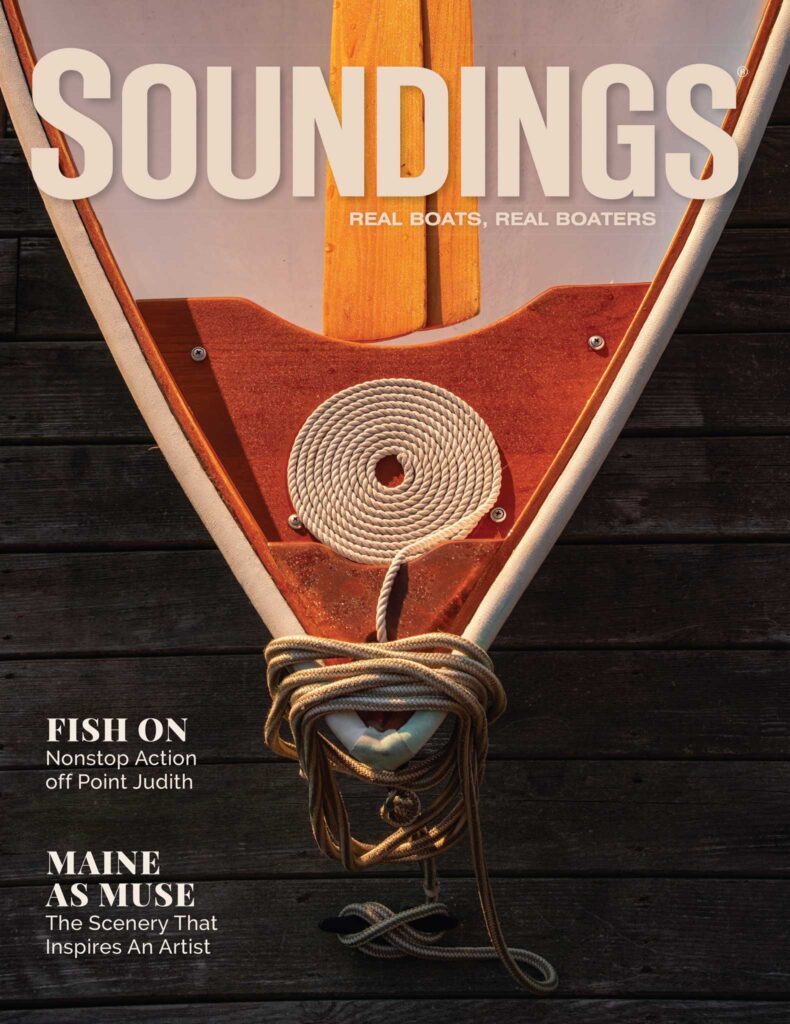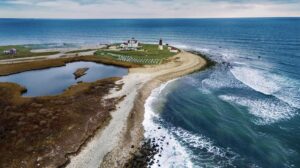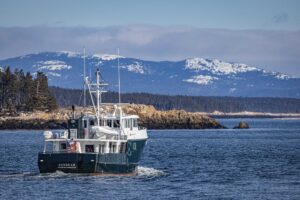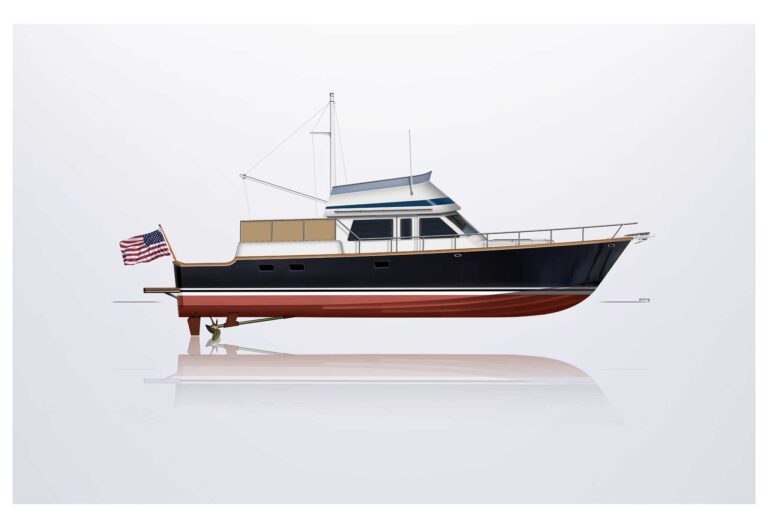The temperature on the morning of Oct. 31, 2007, was 28 degrees near Brooklin, Maine, not cold enough to freeze the water around Red Head, but enough of a chill to tell Ted Okie he should get out of town.

He had allowed enough time to have his new boat built, but there had been delays. Red Head, a 38-foot lobster yacht, had just been launched, and he hadn’t had a shakedown cruise. Nor, as he took her spoked wooden wheel and steered away from the dock, was this going to be one. Okie was on his way — with an untried vessel — to the Bahamas.
Red Head, named not for the stereotypical woman with a fiery personality but for a rocky Maine promontory that glows in the evening sun, would prove to be as reliable as the granite of her namesake. Six months later, she would have more than 4,000 miles under her hull, and Okie, 66, would have nothing but praise for his latest vessel.
The product of a fabricator of fiberglass lobster boats and a respected wooden-boat builder, each working on opposite sides of Penobscot Bay, Red Head is also a distillation of the accumulated nautical wisdom Okie has gathered during six decades of boating on the dozens of boats — power and sail — he has owned. And she typifies the combination of features he finds attractive: seaworthiness, cruiseability and a certain style.
“My father suffered from a similar disease — an addiction to boats. So I grew up on some fabulous things,” says Okie, who divides his time between Pound Ridge, N.Y., and Great Wass Island in Maine. “I started out with a 1913 boat [a Nathanael G. Herreshoff 12-1/2], which I sailed a lot.”
Many boats have followed. In some cases, Okie commissioned their construction. Other times, he salvaged wrecks and restored them. Some of his boats were pedigreed classics, all of them wooden. With Red Head, out of fear of shipworms, Okie strayed to fiberglass. He has not been disappointed.
Red Head is “sound and comfortable,” says Okie, a semiretired real estate developer who builds residential housing in New York City. “It’s [a good way] to stay on the water, enjoy it, cruise on it, and take everything you need to stay quite a number of days away from the dock.” He calls it “one of the prettiest boats built in fiberglass.”
Building Red Head, Okie melded the work of two contradictory personalities. Glenn Holland, who built the fiberglass semidisplacement hull and deck and installed the engine, is exuberant and boastful. Doug Hylan, who has built or restored several of Okie’s boats and finished Red Head in wood with a classic flair, has a quiet sensitivity.
“I can’t swim,” says Holland, whose shop is in Belfast, on Penobscot Bay’s western shore. “And non-swimmers build better boats.” The 38-foot lobster boat hull he built for Okie is the “best one out there, period, that’s all,” he says.
Hylan, whose shop is in the wooden-boat Mecca of Brooklin, east of the bay, and who will use the words “sin” and “fiberglass” in the same sentence, says simply that the finished Red Head has “a lot of details you wouldn’t find in a fiberglass boat.”
Boats and more boats
Okie’s vision to combine the work of these two builders in the same boat was shaped over many years and many boats. First there was the Herreshoff 12-1/2. He includes that on a list of the most significant of his pre-Hylan boats, along with the Herreshoff New York 30 Caramia, built in 1905, which he owned until a friend demolished it on a reef.
“My dad had boats all his life, too,” says Okie, who sailed to Maine as a child with his father, getting “sunburned and bored to tears.”
But he has pleasant memories of the family’s Herreshoff 23; of a Colin Archer-designed boat that had been around the world and, when the family bought it in Florida, had bugs in it; and of “some Concordia yawls.”
“We started with peculiar boats, not production boats, although some of those I like,” says Okie. “This spans about 50-plus years. The objectives changed, and there were different masters as regards to my desires.”
By the time he approached Hylan with a boat project in the 1980s, he was dealing with a lung disease that necessitated an ever-ready oxygen concentrator, a contraption that became a new “master” and slowly pushed Okie from sail to power.
“He had contacted us about building a Bill Garden design, sort of a salmon trawler yacht [called Dynamo],” Hylan recalls. “We worked with him a bit on that.” But the project provided too little room on board for the cost, Hylan says. “We didn’t hear from him for a while.
“Later he called up and asked if we would build him a Rozinante,” an L. Francis Herreshoff-designed double-ended sailboat that Hylan says is “not even remotely similar to Dynamo. I thought, Gosh, this guy doesn’t know what he wants. But getting to build a Rozinante is a pretty nice job. [It is] one of the loveliest designs ever drawn. We said OK, and we built the Rozinante for him.”
The boat provided “kind of the last bit of sailing I could do,” says Okie. Still, he wanted another small boat, and he had an idea what that should be. In the 1970s, when he owned Caramia, he had also owned a flat-bottom boat he liked, but didn’t sail very well.
“I always liked deadrise boats,” he says. A deadrise is a variation on a flat-bottom boat in which the bottom is planked from the side to the keel, rather than from side to side, to provide a vee-shape and better handling in rougher water, Okie says. He went to Hylan with the idea of modifying the lines from his flat-bottom skiff, giving it more deadrise and less “rocker,” the curved bottom that lifts bow and stern above the waterline.
The product of this collaboration was a 15-foot Chesapeake Bay crab skiff, which he still owns. “It was a workboat type and sailed like a bandit and still does,” he says. “As soon as I had that, it seemed to me that I’d made a mistake. It was a terrific dinghy, and I didn’t have a big boat to drag it around.”
Thus, for his next project, Okie restored Grayling, a 65-foot sardine carrier. “There was an existing boat, but barely,” he recalls. “She was pretty far gone. There were places you could stick a finger through.”
Like Rozinante, Grayling was a double-ender, a design Okie believes makes a good sea boat. On Grayling, he could bring along a small crowd or handle her himself. She slid easily through the water at a 9-knot cruising speed. Moreover, he appreciated Grayling’s workboat look. “If it’s a workboat,” he says, “those guys weren’t out there taking chances with their lives.”
At the time he owned Grayling, Okie says it would have been difficult to find a boat he felt would be good in 60 knots of wind. “Trawler yachts are extremely high-sided, [with a] high house, and they don’t have much under them,” says Okie. “I would be worried if I were out in 25-foot seas. Grayling would come back. I just don’t think modern boats look safe, and how many double-enders do you see that are new? Almost none.”
Grayling spent 19 months at Hylan’s shop, and when she left, everything except the keel, part of the deadwood and half of the planking had been replaced. “A lot of effort was put into making her look on the exterior as closely as possible to the way she looked when she was built,” Hylan says. Details that today would be considered frills were reproduced on Grayling because they were “really elegant,” he says.
“There was quite a bit of work done of that type,” Hylan continues. “Ted is typically willing to fund that sort of thing. He understands the historical significance of that kind of thing.”
But Okie agreed to one compromise involving high-tech materials. “We put plywood and Dynel decks on her,” says Hylan. “The death of most wooden boats is leaky decks. If you can prevent that, they’re not much problem down in the tropics.”
But on a cruise to the Bahamas in Grayling, Okie nonetheless worried about the risk of shipworms boring into his boat’s hull. “I wasn’t sure I didn’t scrape a little bottom paint off on a sand berm,” exposing wood for shipworms to attack, he says.
The cruising bug
In the 1990s, Okie sold Grayling and moved on to other boats. Hylan reels off the list. “Since Grayling, we’ve built for him a little William Hand, Noank-style lobster boat. We rebuilt extensively a Jonesport lobster boat for him. We also built a little boat called an N.G. Herreshoff-designed Coquina, a little sailing boat [15 feet], two sails — probably the boat Herreshoff owned and sailed more than any other boat.”
Okie named the Coquina for his daughter, Suzanna, 19. “She sails it, and I sail it,” Okie says. The boat has no tiller, but rather is steered by two lines attached to the rudder, like the reins on a horse but in reverse.
“I built an awful lot of boats — building them or getting a hold of wrecks and putting them back together again,” Okie says. “I’ve always loved old-fashioned boats that were seaworthy. Only in the last decade [did I get] interested in cruising.” That focused Okie on finding a boat that could go 4,000 to 6,000 miles during the course of three or four months and “get all the things you need to have done unless you’re a marina hound.”
For Okie, the lure of cruising alone or with one other person is, in part, the adventure and the chance to discover new places. “But I also take 30 to 40 of my favorite books along, and I do a tremendous amount of reading when I’m on the boat in the evenings or sitting on anchor. It’s nice to be able to go through some of the classics, which I do all the time.”
Okie has reread all of Charles Dickens’ works, which he abhorred as a student. Recently, he was alternating between Dostoyevsky and Victor Hugo. “And I try to read all the Pulitzer winners,” he says.
“I do a lot of sketching,” he adds. “I really enjoy it.” On his cruise to the Bahamas, he recorded the trip on countless sketch pages. “If I go into a place like Green Turtle Cay or Royal Harbor … and there’s a particularly decent boat, I will sketch it, or a little town I like or just a seascape.” He tries to spend up to two hours a day sketching.
“I also happen to love to fish. I only fish with a little rod,” Okie says. In blue water, he always has a line overboard, trolling. “An occasional little tuna — no point in catching a big one — like an albacore size, 15 pounds, makes a heck of a dinner.”
That leads to another of Okie’s cruising pleasures: cooking. All of these passions contributed to the plan Okie brought to Hylan when the Red Head project started. But there was more.
In considering a cruising boat, Okie says, “I wanted one that was seaworthy, that could get a good number of miles out of the typical tankage that the hull could take. And I wanted to be able to get out of bad weather if I wanted to. [Speed] was critical.”
Because of his love of Maine, Okie gravitated toward lobster boats. But in recent years, the design of those boats — the pickup trucks of the ocean — had grown beamier and beamier to accommodate more lobster pots. “Some are so beamy that their motion is very quick” — and uncomfortable — Okie says. In earlier years, a lobster boat might have a 10-foot beam. Now, he says, 17 feet is not uncommon.
Lobster-boat builder Holland agrees. “Most today are built for room. They get high, wide and bulky,” he says.
There are two basic lobster boat hulls, Holland explains, built-down and skeg. Built-down boats have a wine glass shape in which the hull curves into the keel. Skeg boats have a sharper transition from hull to keel. Holland builds skeg boats.
“In the old days, a skeg boat would run circles around a built-down type boat,” Holland says. “The guys who built the old built-down boat could have cared less about the speed. Guys who built the skeg boats are a little more [interested in] speed.”
Moreover, a built-down boat rolls more than a flatter skeg boat, he says. “I owned a built-down boat one time that would roll you right to death. She rolled you based on the weather forecast,” he says.
Holland’s round chine hull met Okie’s requirement for aesthetics. For one thing, it had only a 13-foot, 6-inch beam. But it also had a potential top speed of more than 20 knots. He ordered one. “I think one of the biggest reasons he bought it was looks,” Holland says. “Not many people build lobster boats that way any more.”
Hylan used Holland’s hull lines to develop the construction drawings that he would use to finish Red Head. “Ted’s very specific. He has good ideas … very set ideas about some things. He tends to leave the style issue to us,” Hylan says. “He loves to cook, for one thing, so he has some different ideas about how galleys should be arranged. He’s not typically happy with a regular boat stove. He has some requirements for storage of pots and pans.”
Okie also wanted a separate shower in Red Head, and he typically doesn’t want a lot of berths, Hylan says. “He prefers wood boat exteriors, keeping the exterior simple, similar to what it would be like in a workboat,” with a higher level of finish for the interior.
“We’ve worked together for a long time. He likes our style,” says Hylan. “Both of us have enough experience both with boats and with working with each other to know when we’re on the wrong side of an issue. There are always compromises of space.” For example, Okie wanted a bigger galley. “But he wanted it up in the pilothouse, and he wanted to have a short pilothouse. Those two things are incompatible.”
The larger galley was one of the few details on Okie’s list that Hylan couldn’t fit in the boat. Taking a guest through Red Head, Okie ticks off the items that make her a good cruising boat.
Her 500-hp Cummins diesel uses about 0.6 gallons per mile at 18 knots, but does much better at half that speed. Her WhisperGen external combustion generator provides all the electricity needed and also heats water, in almost total silence. The freezer under a deck box in the huge cockpit carries enough food for two weeks away from the dock, and Red Head has a 13.5-gph watermaker. The island in the pilothouse conceals the range top and some slide-out counter space. To port of the starboard-side helm is a counter large enough to accommodate a chart book. On the starboard side of the helm is a sliding door that facilitates picking up a mooring when shorthanded.
All engine maintenance except the fuel tank sumps can be accomplished above the level of the cockpit sole, a necessity because of Okie’s breathing problem. There is a small, foot-button-
operated davit on the stern that, using a self-tailing power winch mounted on a washboard, will launch and retrieve the wooden dinghy without assistance. The outboard can be left in place, further reducing effort.
There are screens in all of the pilothouse windows, and two of the windows on the aft bulkhead are self-draining when opened. Forward of the pilothouse and down two steps, there are two large bunks under the trunk cabin, ahead of the shower to starboard and the head to port. There is a seat to port between the head and one berth. There is a full-size dresser to starboard between the shower and the other berth.
Hylan’s decorative touch is evident in moldings and the vertical staving on the outside of the pilothouse. “It’s the sort of styling that was commonplace in wooden boats, especially workboats, a long time ago,” Hylan says. Another feature, he notes, is the “[running] light boards on the top of the pilothouse with the name [of the boat] on them and sort of an old-fashioned brass lantern. That’s something you almost never see.”
“Doug [Hylan] was very careful of doing a shelter you can sit in, you can cook in, navigate in and still not ruin how a fish boat looks,” Okie says.
No shakedown, no problem
“If we hadn’t lost a couple of months, we would have had sea trials in August or September,” says Okie. “It was getting awfully cold, and we had to get out of there.” The result, as he sailed south to Mystic, Conn., was “quite a number of phone calls: What does this do? What does that do?”
Hylan’s people, who had taken Red Head around Eggemoggin Reach before Okie took delivery, had warned him there were quirks. They told him, “Here’s the books to work them out,” Okie says.
There was a minor engine problem on Delaware Bay that was quickly fixed by Cummins representatives. Another time, a bolt came loose in the shifting linkage. There was a glitch in the chart plotter as a result of not sea-trialing the boat, and Okie had to deal with an error message on the WhisperGen. Other than these and a couple of other minor incidents, he says, the trip to the Bahamas and back was without problems.
“I was pretty amazed, to tell you the truth. The biggest problem was me,” Okie says. “I didn’t have time to sit down with the guys who installed [the systems].”
Now Okie and Hylan are preparing for their next collaboration, a 43-foot double-ended oyster dredge the design for which Okie discovered in “Designs to Inspire,” by Anne and Maynard Bray. “Doug and I have taken that idea and changed it quite a bit, but it is similar,” he says. In addition to a pilothouse — “In the arena of cruising, I’ve fallen in love with these pilothouses,” says Okie — the boat, designed in 1921, has a large center hold and a mast to load cargo.
“A round-stern boat is much slower than a transom boat,” Okie says. “But I have noted that oil has gone up a bit, so I’m interested in finding an engine that is a very slow-turning engine and could push one of these things. It only takes about 50 hp to reach her design speed [8.5 knots]. I think I’m getting old enough to take it easy.”
But he’s not old enough to stay close to home. Red Head was scheduled in early September to start her journey south for another winter in the islands.
This article originally appeared in the October 2008 issue.










